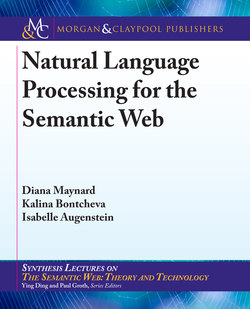Читать книгу Natural Language Processing for the Semantic Web - Diana Maynard - Страница 6
На сайте Литреса книга снята с продажи.
ОглавлениеABSTRACT
This book introduces core natural language processing (NLP) technologies to non-experts in an easily accessible way, as a series of building blocks that lead the user to understand key technologies, why they are required, and how to integrate them into Semantic Web applications. Natural language processing and Semantic Web technologies have different, but complementary roles in data management. Combining these two technologies enables structured and unstructured data to merge seamlessly. Semantic Web technologies aim to convert unstructured data to meaningful representations, which benefit enormously from the use of NLP technologies, thereby enabling applications such as connecting text to Linked Open Data, connecting texts to each other, semantic searching, information visualization, and modeling of user behavior in online networks.
The first half of this book describes the basic NLP processing tools: tokenization, part-of-speech tagging, and morphological analysis, in addition to the main tools required for an information extraction system (named entity recognition and relation extraction) which build on these components. The second half of the book explains how Semantic Web and NLP technologies can enhance each other, for example via semantic annotation, ontology linking, and population. These chapters also discuss sentiment analysis, a key component in making sense of textual data, and the difficulties of performing NLP on social media, as well as some proposed solutions. The book finishes by investigating some applications of these tools, focusing on semantic search and visualization, modeling user behavior, and an outlook on the future.
KEYWORDS
natural language processing, semantic web, semantic search, social media analysis, text mining, linked data, entity linking, information extraction, sentiment analysis
This book is a timely exposition of natural language processing and its role and importance for those seeking to apply semantic technologies. Clearly written with good coverage of the key topics and a comprehensive bibliography, the text will be invaluable for semantic web practitioners and more widely.
Prof John Davies
BT Research & Technology
Adastral Park UK
November 2016
